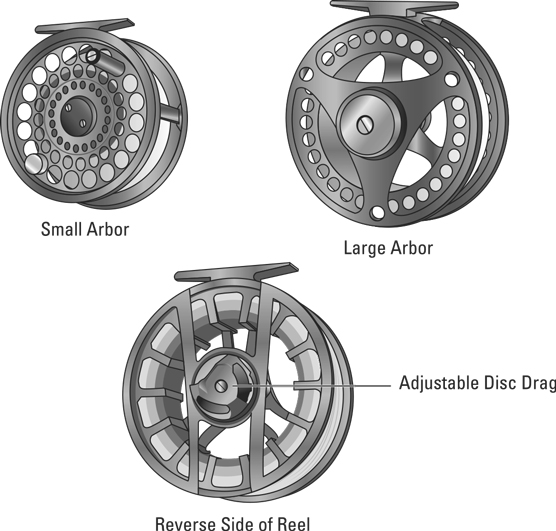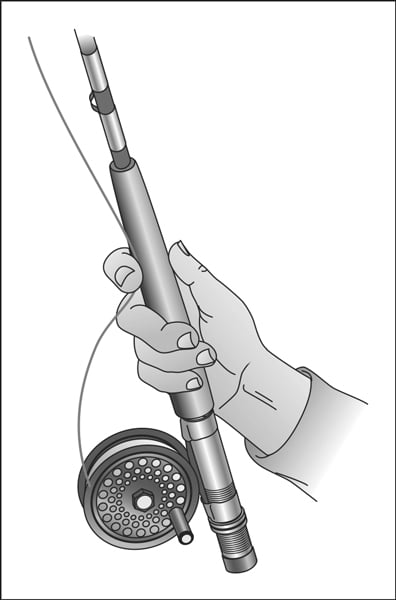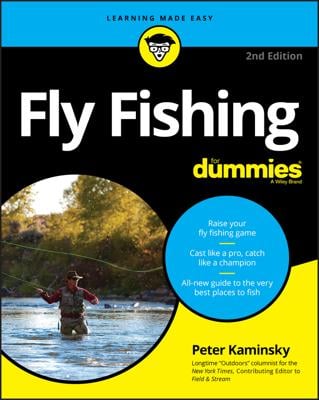A few different fly reels are shown here. A spinning reel can have dozens of moving parts; a fly reel has just a handful.
 Some fly reels.
Some fly reels.The fly reel mounts below the rod. You can configure most reels for winding with either the left hand or the right hand. Because I cast with my right arm, I like to hold the rod in my right hand and the reel with my left. This way, I don’t complicate my life by needing to change hands to fight a fish and can use the strength of my more powerful arm to assist the rod during the fight. On the other side of the equation, some anglers like to reel with their strong arm when fighting big fish.
They say that you do more physical work with the reel when fighting a large fish than you do with the rod. Maybe so, but I’ve found that I do better in all situations cranking with my left hand.
If you’re unsure how to configure your own fly reel, ask the people in the tackle shop to set it up for you when you buy it. If you buy one online, you can still ask the folks at the tackle shop. They may charge, but often this service costs you nothing.
What Does a Fly Reel Do?
Sometimes when I go fishing out in the Rockaways (a long barrier island that protects the Brooklyn and Queens shores from the full force of the Atlantic and its storms), I avoid the expressway and drive up the narrow spit of the Rockaways. To my left is a long promenade running along Jamaica Bay, a rich fishing ground. All along that promenade, I see anglers. Never do I see any fly rodders there. Mostly I see bait guys, with their plastic five-gallon buckets of the kind that you find lying around construction sites.I’m in New York City, however, so I’m not surprised to see that the fishermen use shopping carts to transport their gear to the water’s edge. Every now and again, I see a fisherman without any pole. Instead, he has a hand line, swinging it around to get up speed and then letting it go. If a fish hits, he retrieves the line by wrapping it around a soda or, more likely, a beer can. Basically, that can is a reel, or at least a spool, which is the main line-storing part of a reel.
The first function of a reel is to store the line. Before reels, the angler fished with a fixed length of line, about one and a half pole lengths (Tenkara rods from Japan, which have recently become popular, are just a high-tech variation on this). The reel—by virtue of the line it stores—enables a caster to get more line out farther than just two pole lengths, and it enables the fish to run great distances, tiring as it goes.
The ability to control drag is a significant factor in a fly reel—more so if you’re fighting bigger fish. I can’t say enough by way of praise of adjustable disc drag, which works on the same principle as disc brakes on your car. It was not really available when I started to fish. It is smooth and benefits from not having gears and a lot of moving (breakable) parts.
There are just a few choices to make when buying a reel. Although anglers managed fine through a few centuries with the simplest of reels, recent advances make the right reel a valued part of your fishing arsenal.
My recommendation is a machined reel, one in which the parts are machined—basically sculpted —out of a piece of metal where unnecessary bulk is removed and critical structure remains. The result is a metal skeleton that is strong and durable, yet lightweight. Machined reels cost a little more, but when you do the math, you’ll find that a good reel can easily last thirty years, which works out to a fraction of a penny per fish.
The ABCs of Arbor Reels
One of the most important advances in reel technology is the advent of the large arbor reel. “What’s an arbor?” you may ask (I certainly did). It’s the circular part in the middle of the reel that the line winds around.As you can see from the illustration, with a small arbor it takes more cranks of the reel to wind in line than it does with a large arbor. Think of the way it takes more unwinding at the end of a roll of toilet paper than it does at the beginning. This feature comes into play when fighting bigger fish and/or fish that will take a lot of line as they attempt to run. A larger arbor requires less cranking to retrieve line. For smaller fish, a standard smaller arbor is fine and less bulky. While it’s true that it looks better as a match for lighter equipment, if I had to choose just one, I’d go for a large or midsize arbor. Another bonus is that larger arbors wind the line on in larger circles, and since fly line has what is called memory and tends to kink up, there are fewer kinks with a larger arbor.
Kind of a Drag
When I started fishing, a wonderful American reel called the Pflueger Medalist, which had a very simple drag, was still made. I caught thousands (well, at least hundreds) of fish, including bonefish, with this reel. I still have that reel (on the mantelpiece, not on my rods). It still works, and I’ve never had to replace the drag. But, alas, the day of the classic (and inexpensive) Medalist is gone for most anglers.Nowadays, a most useful innovation is the adjustable disc drag. It is a godsend, especially with larger fish that tend to take off a lot of line as they sprint away from you. Reels with disc drag are useful for fighting big freshwater fish or big saltwater fish because the reels apply drag, or braking, in a smoother, more fluid way, creating a very steady, even tension on the fish, reducing the possibility of line breakage. Plus, they allow you to adjust the drag if more or less is needed to bring a fish under control . . . or maybe it’s better to say “kind of under control.”
Using Your Tools to Stop the Fish (Hint: Your Hand is a Piece of Tackle, Too)
In fishing for most trout and bass, you can use a combination of the following techniques to apply drag:- Use the drag from the reel.
- Raise the rod tip to flex the rod more.
- You may be able to cup the spool and use the palm of your hand as a brake Careful, though, to keep your knuckles away from the revolving crank on the reel. I’ve skinned mine a bunch over the years. Note: Not all reels are built to enable this tactic.
 Use your finger to apply on the line to help when landing the fish, not during the fight.
Use your finger to apply on the line to help when landing the fish, not during the fight.
